Emirates Team New Zealand update
For Nice this week Dean Barker has once again passed the reigns of the Emirates Team New Zealand Extreme 40 back to the Kiwi Cup team’s latest recruit Pete Burling. Burling, current no1 in the 49er class with crew Blair Tuke, has already scored two third places on the Extreme Sailing Series this year. However he has a tough act to follow after Barker steered the Kiwi Extreme 40 to victory in Istanbul three weeks ago, finally ending the unbroken string of victories by either Alinghi or The Wave, Muscat that has lasted since 2012.
“Pete is no stranger to it,” says Barker of Burling’s ability as a multihull helm. “He did events last year and the year before with Team Korea, so he and Blair have slotted in really well with the guys, which is good. And it’s good for our sailing team as a whole to be able to switch around. But the fleet develops through the season with all the momentum, which makes it hard when you try to transition back into it.”
It is now just over a year since the Kiwi calamity in the 34th America’s Cup, when Emirates Team New Zealand was at match point, on 8-1 against Oracle Team USA, only for the defender to change gear and fight back, turning what appeared to be near certain defeat into one of the greatest come backs in sporting history.
“It was such mixed emotions,” admits Barker looking back at it. “It was such a fantastic environment and team to be part of and the team achieved a lot of its objectives along the way. We did everything we set out to do and hit the ground running and when the match started we were sailing at full tilt. Oracle didn’t kick off as well as they probably could have and they weren’t as well organised, but to their credit they did an amazing job to turn things around like they did.”
With 20-20 hindsight, Barker recalls that there were at least four races where fate didn’t smile on them including two where they were leading when the wind limit triggered and the time limit ran out and another when they nearly capsized on one of the upwind legs. “There are just things like that, where you look back… It was frustrating that’s for sure, but the team will certainly be a lot stronger again because of it. It is disappointing to be so close to winning it and not to come away with it. But it was incredible what it did for the sport and lucky in a way that the event was as close as it was. If it had been a one-sided event it wouldn’t have captured the audience that it did.”
Since then Emirates Team New Zealand has carried out a top to bottom internal review searching for the shortcomings of its last campaign. “The team functions very, very well and hit all its objectives all the way through, other than the final outcome. But we have had to see where the issues lie and why we weren’t able to be better than Oracle - everything from our design approach, to the sailing team and how we race. So there are a number of things we are trying to implement now. It starts from right at the top - having stronger governance, a bigger, more involved Board, right through the management structure of how the team was run.”
Clearly one of the biggest issues was that Oracle Team USA found more room for 11th hour development of its AC72 combined with the crew's ability to make their boat foil upwind and perhaps the Kiwis underestimated the gains the defender could make.
Another area is the crew, which as a group remains the most experienced among all the Cup teams, but is also the oldest, hence why young guns such as Pete Burling and Blair Tuke have since been signed up.
“There is no question that we have to refresh the team with new talent, both in the sailing team and the design team - it just sparks new ideas,” admits Barker. “We have already brought in a couple of new guys into the design group who add a huge amount of knowledge and a different perspective.”
While Nick Holroyd remains Technical Director, among the new recruits to the design team are Neil Wilkinson, the Kiwi mechanical engineer who was responsible for the board control mechanism for Oracle Team USA’s AC72s.
However, unlike Luna Rossa and Artemis, Emirates Team New Zealand is a long way from running at full steam at this stage, says Barker. “In total right now we have got about 35-40 people across the team - enough to be making headway, but far from fully operational. We’re not full time designing like Luna Rossa, but we are still making some pretty good progress with the initial concepts and things.”
Barker reckons that when the time comes the team will eventually get up to around 95-100 people. “It is amazing how it always seems to end up there even if the size of the sailing team gets smaller and there’s only one big boat. With the professionalism in terms of looking after the boat, the detailing and all the complexity of all the systems, numbers just keep creeping up.”
The most significant milestone for the team came at the beginning August when Emirates Team New Zealand confirmed its challenge for the 35th America’s Cup. However Barker qualifies this: “Challenging is one thing, making it to the start line is the next thing. There is still a lot of detail that we need to understand, in particular the venue, which has a bearing as to how difficult it is to raise the money.”
The money side is the responsibility of team CEO Grant Dalton. Back in August Dalts was over in the Isle of Man attempting as a newbie to qualify for the Classic TT motorcycling event - classic motorbiking is the great man’s latest pastime and something he has been practicing in NZ. But after that he was due to complete a tour of Team New Zealand’s sponsors to bring them up to date with progress of both the team and the Cup.
So Emirates again? “Hopefully fingers crossed,” says Barker. “I think they have had good experiences with the team, but, like everyone, they need to know where we’re going to be racing. It is nice that there are two options, but it is still not decided.”
Challenger-defender co-operation
Dalton and Oracle Team USA CEO Russell Coutts have become renowned for their ‘rivalry’, a spat which flared up again in late July when the Kiwi team was invited and then strangely uninvited to one of the regular challenger-defender meetings for the 35th America’s Cup. Since then this has been resolved, Emirates Team New Zealand back participating in the weekly meetings or conference calls between the teams. According to Barker, as a matter of course it is he and COO Kevin Shoebridge, rather than Dalts, who take part in these meetings and any interaction between the team and ACEA.
Barker maintains that the reported rankling between Emirates Team New Zealand and ACEA has been over dramaticised: “We are certainly not anti the Protocol or what Oracle is trying to do. We are not trying to undermine the event at all. All the teams are entitled to a view on what they make of it all and if we thought it was that bad, we wouldn’t have challenged. The great thing at the moment is that the teams seem motivated to work together. I think this next event is going to be great and it is great that there are going to be five challengers.”
The degree of co-operation between challengers and defender is unusual for this Cup. Although Luna Rossa has technically inherited the role of Challenger of Record following Team Australia/Hamilton Island YC’s retirement, the Italian team seems keen for this role to be a collective one between all (five at present) of the challengers.
“It seems like everyone shares a common goal in that they want the event to be successful,” says Barker. “Where things become hard is to all agree, because teams are at different stages of funding and progress. Luna Rossa is probably the most progressed in that they have been working away since January. Artemis have been going well and Ben looks like he has some momentum now. Our guys have been busy, but we are a long way away from being fully operational.” And Team France currently seems to be the furthest from getting to the start line.
While there is talk of potentially more challengers revealing themselves before the end of the year and their late arrival would normally put them very much on the back foot, this is potentially less the case for the 35th AC. For the last Cup teams could sell their ‘design package’, as Team New Zealand did to Luna Rossa to help the late Italian entry get up to speed. This time around the Protocol allows a team’s designers to work for two teams all the way through the Cup cycle, allowing even more opportunity for a late team to get up to speed quickly.
As Barker observes: “It seems that most of the teams are gearing up to doing their own design work as opposed to buying a design package, but if another team started up late they could buy back the time.”
As to one of the more controversial new features of this America’s Cup – splitting what was once known as the Challenger Selection Series/Louis Vuitton Cup in two, with the first part (the America’s Cup Qualifiers) being held in one venue and the second part (the America’s Cup Challenge Play-Offs) in the official Cup venue – Barker says Emirates Team New Zealand would prefer just one venue. “The two venue option may be a good way of trying to raise more money for the event, but it certainly increases the cost for us, because you have got your pack up and moving and everything else. All the teams would much prefer to just have one venue – to go there, prepare and do the round robins and semis and finals all in one spot. And I’m not even sure it’s guaranteed that San Diego and Bermuda would form the two venues for a split venue.”
As to whether he has a preference for either San Diego or Bermuda, Barker says: “It is no secret that for us the west coast of the USA is pretty nice. It opens up a much bigger target market for our sponsors to be in the US and it is great time zone for us. I’m sure Bermuda has a lot of great aspects as well - you have a bit more space there to have a decent race track, while in San Diego you are quite constrained in certain wind directions, but saying that, you could shorten the race course up and do more laps…
“It is difficult because you have got two completely different prospects – the way it was best described to me, one is a prestigious golf tournament and the other one is more of your race village atmosphere. It is a case of trying to determine which is the better option.”
AC62
As to the weapon for the 35th America’s Cup, the new AC62 catamaran, Barker says: “In general the rule looks interesting. It’s shut down a lot of design space, but at the same time there are still opportunities to tailor a boat, enough of a design element that it is not one design even though a lot of things are, like the wing - even though you build your own wing, all the wings will look the same.”
The performance of the AC62s Barker reckons won’t be far off that of the AC72, but this will be as much to do with design evolution, as to each team’s skill in handling the radical foiling catamarans. “Whereas with the AC72s we were scratching the tip of the iceberg when it came to upwind foiling, with the AC62 that will be the norm - you’ll have to foil upwind. Upwind, you may not reach the potential speeds the AC72s could have done, but it won’t be far shy of that and downwind, because the boat is lighter and the crew weight is a slightly higher percentage of the righting moment than it was on the AC72s, the boats will still be pretty competitive.”
And given that the AC62 rule intends to promote foiling, whereas the AC72’s unsuccessfully attempted to prohibit it, Barker reckons the new catamaran will be much more enjoyable to sail.
“In terms of control systems for the boards, it is more clearly defined and the systems will be more along the lines of what Oracle had, so the boats will be a lot more manageable foiling upwind. I imagine we’ll see the boats foiling a lot more around the course. Saying that, in the two venues that they have selected there will be times when the boats won’t be foiling or they will be at the crossover. The wind information they have published about the two venues, there wasn’t a huge difference in the average wind speed. There is a bit more spread in Bermuda. So what it will be interesting to see where the foiling crossover will be. The last go round [with the AC72s] it probably got down to as low as 10-12 knots depending on the breeze density and things.”
Barker adds that success this time will partly come down to how well teams can optimise their performance in marginal foiling conditions, and this is potentially exacerbated by the removal from the AC62s of the genniker, which will potentially make the boats underpowered downwind in light conditions. “You’ll have some pretty interesting races if the breeze shuts down…” Saying this, there remains some flexibility in the AC62 rule as it stands so that, for example, mast height could be increased if it was thought necessary for a light wind venue.
$$$$
So will this America’s Cup be any cheaper for the challengers? “In some ways the Protocol has helped to reduce the cost, by reducing the size of the boat and you have only got one boat. So there are less people needed to launch it, to service it and maintain it," says Barker.
“But the surrogate boat program is potentially going to be a hell of a lot more expensive than it was last time because they are allowing the AC45 to be a surrogate boat. They form a three quarter scale version of the AC62 and there is no limit to how much you can spend on boards and systems and wings, etc. If you had the budget and inclination you could easily spend on that what you saved on doing a second boat. So there is a little imbalance there. Last time we used two SL33s as our development tools, which was great because then you had to use a boat of 10m or less. If they had kept the 10m rule as before that would have helped reduce a lot of the cost. Building in AC45 scale is pretty expensive, but it is in Oracle’s interest because that keeps Core Composites ticking along with boats to build.”
Meanwhile as the final pieces of the 35th America’s Cup jigsaw puzzle are put in place, Barker is spending some time focussing on his personal sailing. This has included the A-Class catamaran, in which he has been hanging on to the coat tails of the team’s wing trimmer, multiple A-Cat World Champion Glenn Ashby.
But Barker’s latest acquisition is a Mach 2 Moth. “It turns up in a box with pretty detailed instructions about how to put it together - it took me two days - and then you go sailing and the thing just pops straight up on the foils. In a straight line it’s absolutely fine but then when you decide you actually have to start turning…”
Within the team Ray Davies has been Moth sailing for some time now and according to Barker even cat specialist Glenn Ashby is soon to join its ranks, spurred on by January’s Moth Worlds taking place in Sorrento near his home in Australia. As to whether or not Barker goes, he says this will depend on how adept he’s got at it. “It would be incredibly frustrating to go over there to spend the whole time swimming around! But you can see why those skiff guys adapt so well.”

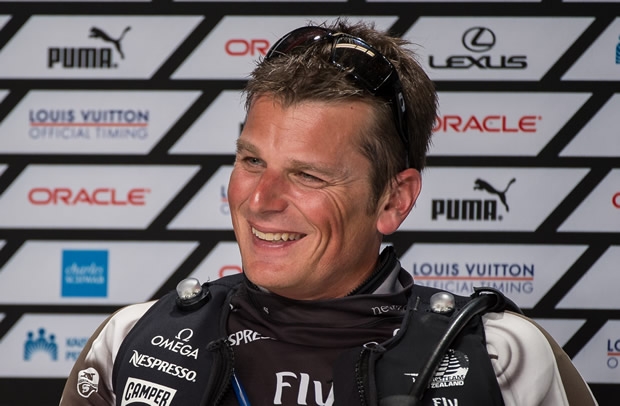
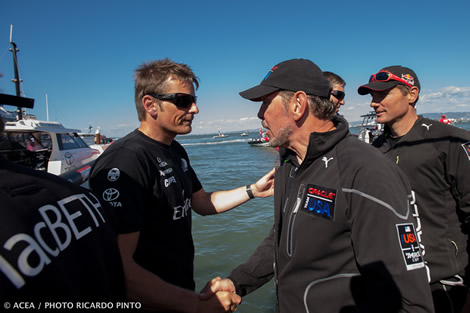
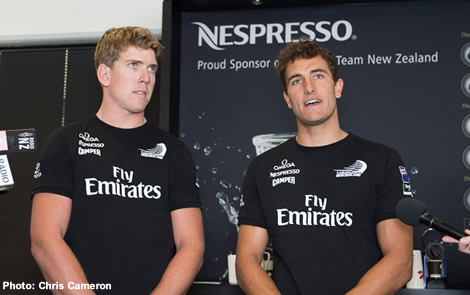
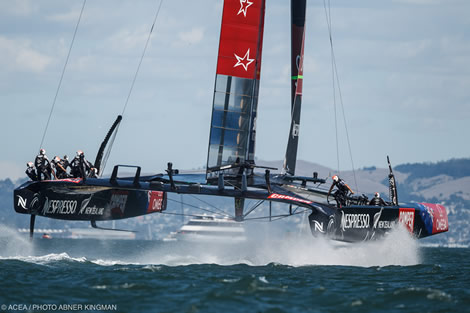
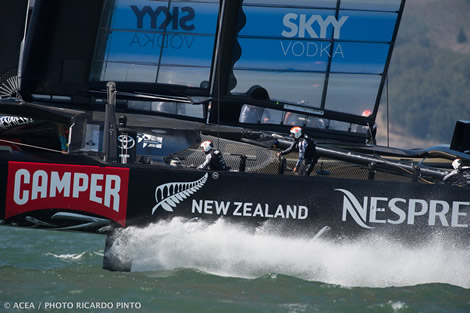
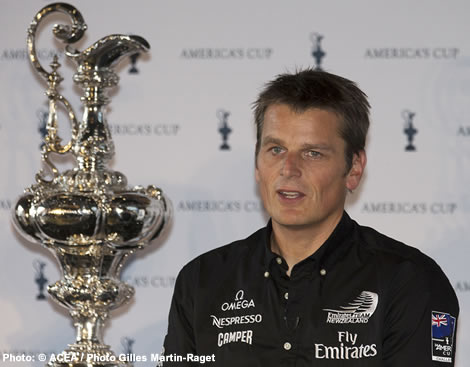







Latest Comments
david_collins 03/11/2014 - 16:46
Speaking from my A-cat sailing experience, the issue of light air downwind sailing is facilitated by sailing a hotter angle - even almost a beam reach to keep boat speed up. I am a believer! I can't wait to see the new boats in action.Add a comment - Members log in